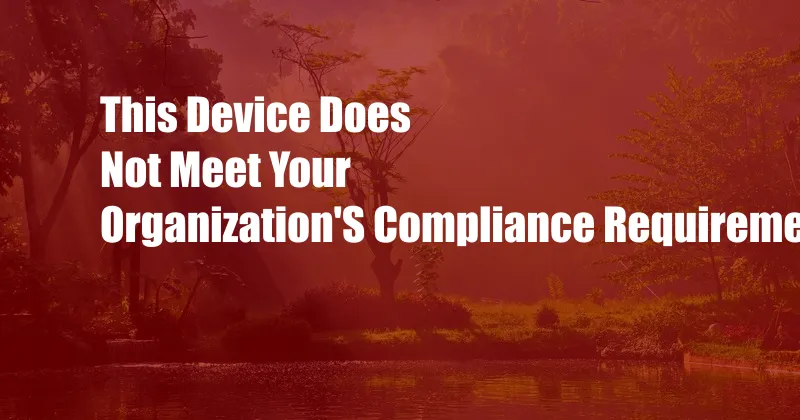
Understanding and Navigating the Ripple Effect of “This Device Does Not Meet Your Organization’s Compliance Requirements”
As a seasoned IT professional, I have encountered the frustrating message “This device does not meet your organization’s compliance requirements” countless times. Initially faced with bewilderment, I delved deeper into the implications of this error, uncovering the intricate interplay between security policies, device management, and productivity.
Compliance Regulations: The Bedrock of Cybersecurity
Organizations operate in a multifaceted regulatory landscape, governed by industry standards and legal frameworks. Compliance regulations aim to safeguard sensitive data, protect intellectual property, and ensure adherence to ethical and legal requirements. They define the minimum security measures and protocols that organizations must implement to protect against cyber threats and data breaches.
Device Compliance: Ensuring Alignment with Organizational Policies
Device compliance plays a pivotal role in upholding organizational security standards. Compliance policies mandate that all devices accessing sensitive information or critical systems adhere to prescribed security configurations and software updates. Devices that fail to meet these requirements pose significant security risks and are barred from accessing corporate networks and resources to prevent data compromise and malware infections.
Common Compliance Requirements
Compliance requirements typically encompass various aspects of device security, including:
- Operating System Updates: Regular OS updates address security vulnerabilities and patch known exploits.
- Antivirus/Anti-Malware Software: Essential for detecting and neutralizing malicious software threats.
- Firewall Configuration: Firewalls restrict unauthorized access to devices and networks.
- Encryption: Encryption safeguards data at rest and in transit, preventing unauthorized access.
- Password Policies: Robust password policies enforce minimum password length, complexity, and expiration periods.
- Multi-Factor Authentication (MFA): MFA adds an extra layer of security by requiring multiple authentication methods.
Consequences of Non-Compliance
Non-compliance can have severe consequences for both organizations and individuals. Organizations face increased susceptibility to cyberattacks, data breaches, and reputational damage. Individuals may experience loss of access to critical resources, productivity impairments, and potential legal liability.
Tips and Expert Advice for Ensuring Compliance
- Regularly Update Devices: Keep all devices, including laptops, desktops, and mobile devices, up-to-date with the latest operating system updates and security patches.
- Utilize Antivirus/Anti-Malware Software: Install and maintain a reputable antivirus/anti-malware software solution to protect against malicious software threats.
- Enable Firewalls: Configure firewalls to block unauthorized access to devices and networks.
- Encrypt Data: Utilize encryption methods to safeguard sensitive data stored on devices and in transit.
- Enforce Password Policies: Implement robust password policies to prevent unauthorized access to accounts.
- Enable Multi-Factor Authentication (MFA): Add an extra layer of security by requiring multiple authentication methods for accessing sensitive information.
Expert Insights from the Field
According to a recent survey conducted by the Information Security Forum (ISF), 84% of organizations have experienced a data breach in the past 12 months. Non-compliant devices were identified as a significant contributing factor, highlighting the critical importance of device compliance.
Industry experts emphasize the need for a comprehensive approach to cybersecurity, encompassing both technical measures and employee education. By ensuring that all devices accessing sensitive information meet compliance requirements, organizations can significantly reduce the risk of cyberattacks and protect their valuable data.
Frequently Asked Questions (FAQs)
Q: How can I check if my device meets compliance requirements?
A: Contact your organization’s IT department or refer to your company’s security policy for specific compliance guidelines.
Q: What happens if my device does not meet compliance requirements?
A: Access to corporate networks and resources may be restricted until compliance is restored. Contact your IT department for assistance in resolving the issue.
Q: What should I do if I have questions about compliance?
A: Reach out to your IT department or security officer for clarification and guidance.
Conclusion
Navigating the complexities of “This device does not meet your organization’s compliance requirements” entails a deep understanding of compliance regulations, device management, and cybersecurity best practices. By adhering to these guidelines and implementing the tips outlined above, organizations and individuals can mitigate security risks, protect valuable data, and ensure seamless productivity.
Are you interested in learning more about device compliance and its impact on organizational security? Share your thoughts and experiences in the comment section below.